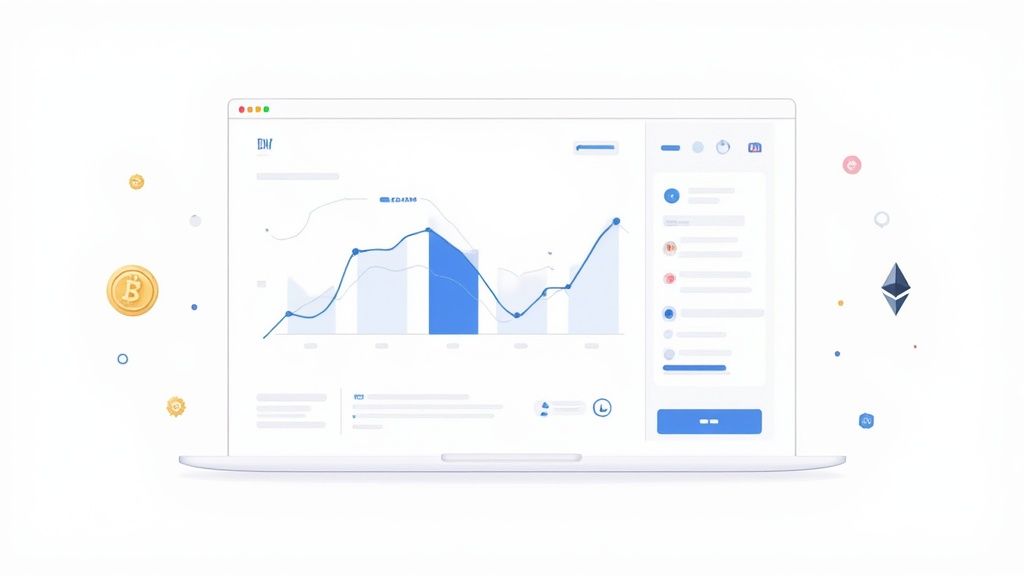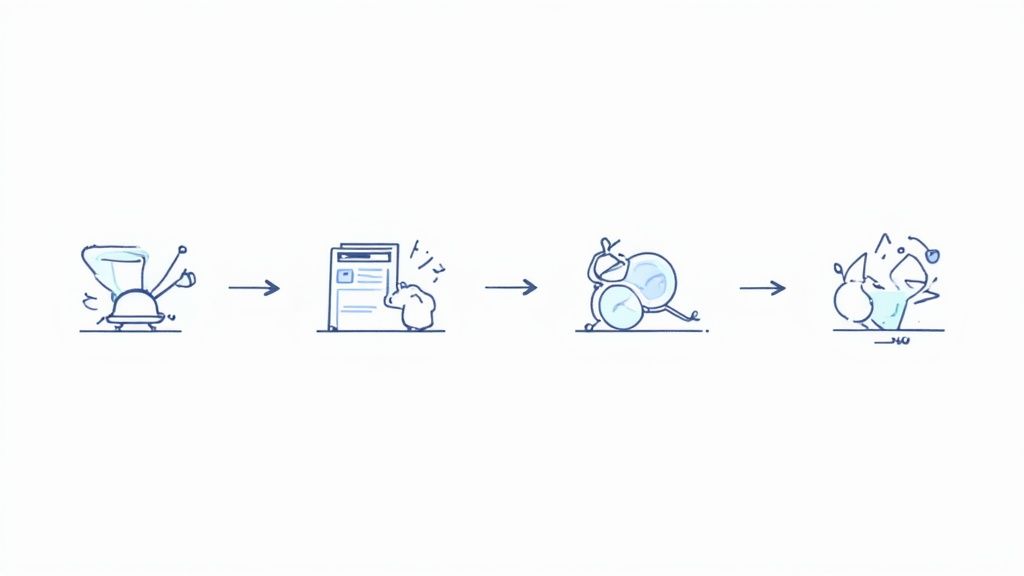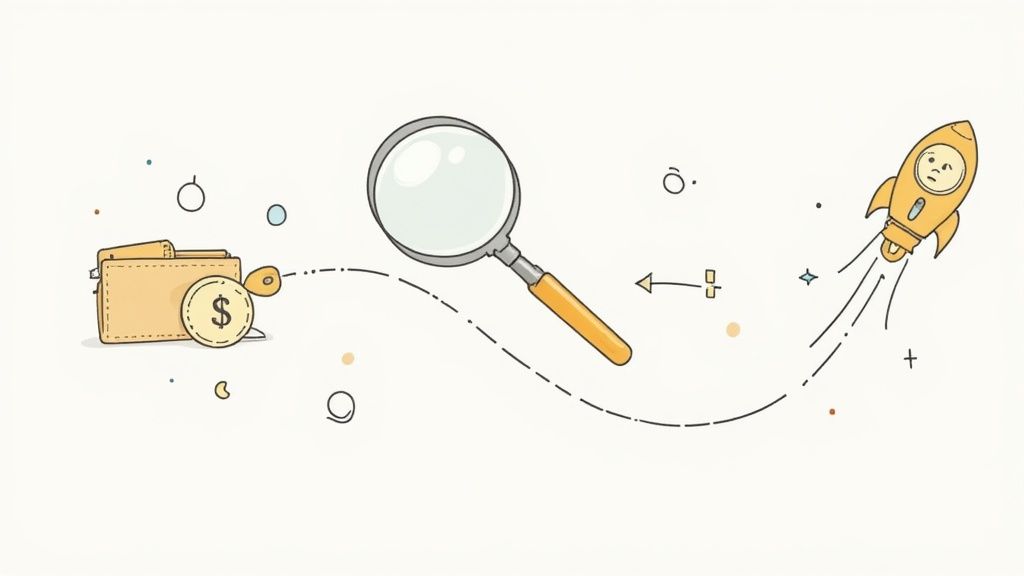Your DeFi Portfolio Tracker Guide
Discover the best DeFi portfolio tracker to simplify your crypto life. This guide covers essential features, security, and how to find the right tool for you.

November 24, 2025
Wallet Finder

November 25, 2025
Think of a crypto wallet tracker as an analytics platform for your on-chain activity. It connects to the public blockchain, pulls data from any wallet addresses you want to watch, and crunches the numbers for you. It goes way beyond just showing a simple balance, giving you a full performance dashboard with true profit and loss, detailed trade histories, and success metrics for any wallet.

Your everyday crypto wallet—like MetaMask or Phantom—is like a bank statement. It shows what you have right now, but it doesn't tell you the story of how you got there. It can't show you if you're actually profitable.
A crypto wallet tracker, on the other hand, is like hiring a personal financial analyst. It combs through every single transaction to reveal your real investment performance, showing you what’s working and what’s not.
These tools pull the complete history of swaps, buys, and sells straight from the blockchain. They then turn that raw, messy data into clean, actionable insights that would be a nightmare to calculate on your own, especially if you're active on more than one chain.
Understanding the difference here is crucial for any serious trader. A wallet's main job is secure storage and executing transactions. A tracker’s job is deep performance analysis. While we're focused on crypto, this isn't a new concept; you can see the general principles of tracking software applied across many other industries.
This kind of analysis is becoming non-negotiable. The global crypto wallet market was valued at around USD 18.96 billion and is expected to hit USD 54.79 billion by 2032, with a compound annual growth rate of 30.4%. That explosion in users means more demand for smarter tools to actually manage and analyze everything.
A tracker also solves one of the biggest headaches for active users: portfolio fragmentation. If you use wallets on Ethereum, Solana, and Base, your wallet apps can't give you a single, unified view of your overall performance. A crypto wallet tracker stitches all that data together into one clear dashboard.
A crypto wallet tracker transforms the public, and often chaotic, ledger of the blockchain into a coherent story about performance. It's the difference between seeing a list of transactions and understanding the strategy behind them.
To really nail this down, let’s put their core functions side-by-side.
The table below breaks down the fundamental differences between the wallet you use to transact and the tracker you use to analyze.
In short, your wallet holds the keys, but a tracker gives you the map and the compass, showing you where you've been and helping you figure out where to go next.

At its heart, a crypto wallet tracker is a machine for turning the messy, chaotic data on the blockchain into a real strategic edge. It does this through a handful of key features that cut through the noise and automate the grunt work of portfolio analysis. Each feature is like a different lens, letting you see market movements and wallet performance in a completely new light.
Think of it like a pro sports analytics platform. Instead of just showing the final score, it breaks down every single play, tracks how players perform over time, and flags the moments that change the game. A wallet tracker does the exact same for your on-chain moves, transforming a long list of transactions into intelligence you can actually use.
These tools are becoming non-negotiable as the crypto world expands. By mid-2024, the number of global crypto owners swelled to over 562 million, and that figure just keeps climbing. This massive user base needs better tools to handle the complexity, and you can dig into more of these cryptocurrency stats and trends on Kraken.com.
The first, most basic feature is on-chain aggregation. If you’re trading on Ethereum, flipping NFTs on Solana, and farming yield on Base, your assets are scattered all over the place. A tracker’s job is to pull all that scattered data into one single, clean dashboard.
This means you get one unified view of your net worth and performance across every chain and wallet you own or follow. No more hopping between different block explorers or apps, trying to piece together the full picture yourself.
Maybe the single most valuable feature is accurate Profit & Loss (PnL) tracking. Anyone who's tried knows that calculating your true PnL in crypto is a nightmare, thanks to gas fees, multiple buys and sells, and different cost bases for your tokens.
A solid wallet tracker automates this entire headache. It digs through the complete trade history for a wallet or a specific token and spits out your realized and unrealized gains with precision. This clarity is everything when it comes to figuring out which of your strategies are actually making you money.
A wallet shows you what you have. A tracker with PnL calculation shows you how you did. That difference is the bedrock of data-driven trading—it’s what separates guessing from having a genuine strategy.
The best platforms take it a step further, breaking down your PnL by token, by individual trade, and across whatever timeframe you choose. This helps you spot your biggest winners and double down on what’s working.
The crypto market moves ridiculously fast. Custom alerts are your personal early-warning system, pinging you the second a wallet you're watching makes a move. You can set up notifications for specific actions, like:
These alerts, usually sent through Telegram or as push notifications, shrink the gap between seeing an opportunity and acting on it.
Finally, advanced filtering is how you cut through the insane amount of noise. Instead of manually digging through thousands of wallets, you can apply specific rules to find exactly what you’re looking for. A powerful tracker will let you filter by:
This feature transforms the massive ocean of on-chain data into a short, targeted list of wallets with high potential, saving you a ton of time.

Okay, so we've covered the core features. But the real magic of a crypto wallet tracker isn't just watching your own bags—it's about seeing what the most profitable players are doing in real time. This is where theory ends and the money is made.
Top traders use these tools to turn on-chain data into a repeatable playbook for finding their next big trade. By systematically analyzing the moves of successful wallets, you start to see patterns and strategies that are invisible to most of the market. It’s like getting a behind-the-scenes look at how the sharpest minds operate. Every transaction tells a story, and a good tracker is your Rosetta Stone.
One of the most powerful things you can do is strategy discovery. Instead of trying to reinvent the wheel, why not find wallets with a proven track record of insane returns and just... see what they're doing? A solid wallet tracker lets you filter for wallets with the highest PnL or most consistent win rates, giving you a curated list of top performers to study.
Once you find a wallet that resonates with your style, you can effectively start copy trading. Now, this doesn’t mean you should blindly mirror every single move. That’s a recipe for disaster. It's more about setting up alerts that ping you the moment they buy a new token. This gives you a critical signal, allowing you to do your own quick research and decide if you want to get in before the rest of the market catches on.
Here’s a simple workflow to get you started:
If you’re hunting for those high-risk, high-reward plays like memecoins, a wallet tracker is non-negotiable for finding true alpha. The whole game is about spotting when "smart money" is quietly building a position in some new, low-cap token before it blows up on Twitter. These are often the same wallets that nailed the last memecoin cycle.
By tracking these wallets, you can see their first small buys into a project, sometimes weeks before anyone else is talking about it. That's one of the most potent signals you can get—it means someone with a history of success thinks a token has legs.
Spotting a cluster of highly profitable wallets all buying the same obscure token is one of the strongest on-chain signals you can find. It’s the digital equivalent of seeing a group of pro investors quietly buying up real estate in an overlooked neighborhood.
Zooming out, a crypto wallet tracker also works as a surprisingly powerful tool for market sentiment analysis. By watching the flow of funds to and from major centralized exchanges, you can get a gut check on what the market is thinking.
This macro view gives you valuable context. It helps you figure out if the broader market is feeling greedy or fearful, so you can position your own strategy accordingly instead of just trading in a vacuum.
Having a crypto wallet tracker is a bit like getting a backstage pass to the market—it lets you see what the pros are doing when nobody's watching. But just having the pass isn't enough; you need to understand the language of the blockchain to turn that access into an advantage. This is what separates the gamblers from the strategists.
The real skill is learning to read the story behind the transactions. A single massive win could be a fluke, but a pattern of consistent, smart trades points to a genuine edge. By focusing on a few key metrics, you can learn to spot the difference and find the wallets actually worth paying attention to.
First things first, you need to filter for consistency. A wallet that hits a 100x on a memecoin is interesting, sure, but a wallet that consistently grinds out profits, week after week, is a goldmine. This is where you have to look past the flashy total PnL figure.
Get in the habit of checking these core performance stats:
This initial screen cuts through the noise. It helps you zero in on wallets that have a real, repeatable edge, which is far more valuable than a one-hit wonder. If you want to dive deeper into these techniques, check out our complete guide to on-chain analysis.
Once you've found a consistent trader, it's time to go deeper and figure out how they're winning. This is where you uncover the mechanics of their strategy. It’s not just about what they buy, but when they buy it, when they sell, and how much skin they put in the game.
Start with their entry and exit timing. Does this wallet seem to get into tokens before the hype train leaves the station? Do they sell near the top, while everyone else is still piling in? A good wallet tracker with a clear visual trade history makes this incredibly easy to spot. You'll quickly see if they're leading the pack or just following it.
Just as critical is their position sizing. Is this trader making a few huge, high-conviction bets, or are they spreading their capital across dozens of smaller plays? This tells you a lot about their risk appetite. When you see a trader methodically adding to a position, it’s a powerful signal of their confidence.
A trader's true skill is revealed not in their biggest win, but in the discipline of their average trade. Consistent timing, smart position sizing, and a clear risk management strategy are the fingerprints of a professional.
This next-level analysis also means looking at their broader portfolio moves. For example, watch their stablecoin flows. It's a subtle but powerful signal. Recently, stablecoin transaction volumes shot up by 83% year-over-year, hitting over USD 4 trillion in on-chain volume. Understanding how top traders are using stables—whether they're cashing out to de-risk or loading up to pounce on a new opportunity—gives you priceless context for their next move. You can find more data on this trend in the TRM Labs' 2025 report.
Diving into a crypto wallet tracker opens up a new world of strategic insights. But let's be honest—it's natural to feel a bit hesitant about connecting anything to your financial data. The most important thing to get straight is how the good trackers work so you can use them without ever putting your funds on the line.
The secret is that legitimate platforms are "read-only" tools. Think of them like a block explorer, but with a powerful analytics engine bolted on top. They only look at public data from the blockchain and will never, ever need your private keys or seed phrase.
A reputable crypto wallet tracker will never ask for your private keys or seed phrase. If a platform requests this information, it is a scam designed to drain your funds. Your keys are for signing transactions, not for analysis.
This "read-only" principle is the bedrock of their entire security model. Because the tracker can't execute transactions on your behalf, your assets stay completely under your control and are never exposed.
While your funds are safe, privacy is another beast entirely. Blockchains are public by design. When you add several of your wallet addresses to a single tracker dashboard, you're essentially linking them together in one place, creating a much clearer picture of your on-chain life.
This is a bit of a double-edged sword. On one hand, it gives you that unified view for your own analysis. On the other, if just one of those addresses is ever tied to your real-world identity, your entire transaction history across all linked wallets could suddenly be de-anonymized. The challenge of staying private is a constant in crypto, and it's worth learning about broader strategies for how to stay anonymous online to protect your digital footprint.
To use a crypto wallet tracker safely and keep your privacy intact, stick to these essential guidelines. They’ll help you spot bad actors and protect your information.
Ready to turn on-chain data into your strategic advantage? Getting started with a crypto wallet tracker is a straightforward process. This final section gives you a simple framework to pick the right tool, bake it into your daily workflow, and start pulling out actionable insights right away.
The first step is picking a platform that actually fits your needs. Not all trackers are created equal, and a quick evaluation now can save you a ton of headaches later. You want to focus on the core features that will genuinely impact your trading decisions and make your research faster.
Before you even think about committing to a subscription, run through this quick checklist. Your goal is to find a tool that’s powerful, easy to navigate, and—most importantly—gives you accurate and timely data. A good crypto wallet tracker should feel like a natural extension of your brain.
Here’s what to look for:
One quick note on security: these tools are designed to be safe because they operate on a read-only basis. They're just looking at public information on the blockchain.

This process simply means the tool reads public blockchain data. It never gains access to your keys, so your funds are always completely secure.
Once you've picked a tracker and signed up for a trial, don't try to boil the ocean. Follow this simple workflow to get your bearings, test out the core features, and confirm it’s the right fit for you. This methodical approach helps build confidence and shows you the platform's value firsthand.
By following these steps, you’ll quickly go from being a passive observer to an active analyst. You'll be fully equipped to use a crypto wallet tracker to find your next big opportunity.
You're probably wondering about a few things. That's good—it means you're thinking like a trader. Let's tackle some of the most common questions that come up when people start using wallet trackers.
Absolutely, as long as you're using a reputable tool. The key is that they operate on a 'read-only' basis. Think of it like using a block explorer—they're just looking at the public data on the blockchain. They never need your private keys or seed phrase to do their job.
This design means they have zero ability to touch or move your funds. That said, you always have to be on the lookout for scam sites pretending to be the real deal. The golden rule of crypto security always applies: never, ever enter your private keys into any website, tracker, or analytics tool. Period.
Pretty much. If the wallet is on a supported public blockchain, you can track it. All you need is the public wallet address (like an Ethereum address that starts with '0x...').
Everything—from transaction history to token balances—is public information just waiting to be analyzed. Just remember, while you can see everything a wallet does, you can't see who is doing it unless they've publicly connected their identity to that address somewhere.
This is where the real alpha is. Finding profitable wallets to follow is a skill, but there are a few proven ways to get started and uncover traders who consistently get it right.
Here are a few tactics the pros use:
Ready to stop guessing and start making data-driven trades? Wallet Finder.ai gives you the on-chain edge to discover top wallets, get real-time alerts, and act on smart money moves before the crowd. Start your free trial today and see what the pros are trading.
"I've tried the beta version of Walletfinder.ai extensively and I was blown away by how you can filter through the data, and the massive profitable wallets available in the filter presets, unbelievably valuable for any trader or copy trader. This is unfair advantage."
.avif)
Pablo Massa
Experienced DeFi Trader